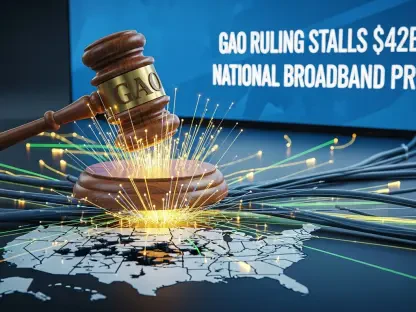In the fiercely competitive arena of European telecommunications, Orange has emerged as a standout performer with its striking Q2 financial results, sparking intense debate among investors and industry analysts about the durability of its success. The company’s EBITDAaL—a critical gauge of profitability—surged impressively, reflecting robust growth in key markets and prompting a deeper examination of whether this uptick signals a fleeting triumph or a solid foundation for long-term dominance. Amidst a sector burdened by high capital demands and relentless pricing wars, Orange’s performance offers a glimmer of hope for stability and innovation. This analysis delves into the intricacies of the company’s financial achievements, strategic initiatives, and the regional disparities that shape its trajectory. By unpacking operational strengths alongside looming risks, the aim is to determine if Orange can transform this momentary win into a lasting competitive advantage in a challenging landscape.
Financial Highlights: Unpacking the Profitability Metrics
Orange’s financial report for Q2 has turned heads with an EBITDAaL of PLN 891 million, showcasing a year-over-year growth of 4.3% and a quarter-over-quarter rise of 5.5%, figures that underscore a strong operational core. Poland emerges as the crown jewel in this performance, with Orange Polska posting a remarkable 28.2% EBITDAaL margin, fueled by a 6.8% revenue increase in essential services such as mobile and fixed broadband. This achievement highlights the effectiveness of focused market strategies in driving profitability. However, the broader European landscape presents a more nuanced picture, with France managing a steady yet underwhelming 0.9% growth and the region overall recording a 2.2% uptick. These gains are tempered by struggles in markets like Germany, where declining equipment sales and pricing pressures weigh heavily. The disparity in results across territories raises critical questions about the consistency of Orange’s financial momentum.
Beyond the headline numbers, Orange’s financial health reveals a calculated approach to sustaining growth while managing inherent industry constraints. A net debt-to-EBITDAaL ratio of just 1.1x signals a conservative stance on leverage, providing a cushion against economic volatility that often plagues capital-intensive sectors. The projected organic cash flow of at least €3.6 billion by year-end, coupled with a 7.7% increase from the first half, reflects confidence in operational efficiency. Additionally, the decision to raise the interim dividend to €0.30 per share speaks to a commitment to rewarding shareholders even as investments ramp up. Yet, the mixed regional outcomes suggest that translating these financial strengths into uniform success remains a complex challenge, with potential vulnerabilities in less robust markets casting a shadow over the broader sustainability of this profitability surge.
Strategic Vision: Infrastructure and Beyond
Orange’s forward-looking strategies are as ambitious as they are essential, with significant investments in infrastructure laying the groundwork for future competitiveness in a digital-first era. In Poland, a substantial PLN 75 million was allocated in Q2 to expand fiber optic coverage, targeting an additional 700,000 households by 2032, while simultaneously accelerating 5G deployment to meet soaring connectivity demands. These initiatives, though cost-intensive with a 1% rise in indirect expenses due to labor and infrastructure pressures, position Orange at the forefront of next-generation networks. The focus on cutting-edge technology is not merely a reaction to market trends but a deliberate effort to secure a leadership role in high-speed internet access, potentially redefining customer expectations and loyalty in key regions.
Complementing these infrastructure bets is a broader vision encapsulated in the “Lead the Future” strategy, which seeks to diversify revenue streams beyond traditional telecom services. By venturing into high-growth domains such as cybersecurity, including quantum-resistant cloud solutions, and AI-driven customer analytics, Orange aims to carve out new competitive advantages. In Spain, the MASORANGE joint venture exemplifies a pragmatic approach to cost-sharing, reducing capital expenditure burdens while hastening fiber network rollout. These strategic pivots, while promising, come with execution risks and substantial upfront costs that could strain short-term profitability. The balance between innovation and financial discipline will be pivotal in determining whether these moves translate into enduring market strength or remain ambitious gambles.
Investor Confidence: Stability Amidst Growth
For investors, Orange presents a compelling blend of stability and potential, underpinned by a disciplined financial framework that mitigates some of the telecom sector’s notorious volatility. The company’s conservative capital expenditure target of €1.8–1.9 billion for the current year reflects a measured approach to balancing growth initiatives with fiscal responsibility. This prudence is further evidenced by robust cash flow projections and a low debt burden, offering a safety net against external economic pressures. The increased dividend payout not only signals confidence in sustained earnings but also caters to income-focused investors seeking reliable returns in a sector often criticized for thin margins and high spending requirements.
However, the allure of Orange as an investment extends beyond mere stability to encompass growth prospects tied to strategic reinvestment. The focus on emerging fields like digital sovereignty and advanced analytics hints at untapped revenue potential that could appeal to growth-oriented stakeholders. This dual appeal—steady returns paired with calculated expansion—sets Orange apart from many peers grappling with heavier debt loads or inconsistent performance. Still, the uneven regional results and the capital-intensive nature of ongoing projects suggest that investor optimism must be tempered by an awareness of potential hiccups. The ability to maintain this delicate equilibrium between rewarding shareholders and funding innovation will likely define Orange’s long-term attractiveness in the market.
Regional Performance: A Tale of Contrasts
Zooming into Orange’s operations across Europe reveals a patchwork of successes and struggles that highlight the complexities of a fragmented market. Poland shines brightly with its impressive margin expansion and revenue growth in core services, driven by targeted investments and a receptive consumer base eager for enhanced connectivity. This success story illustrates how localized strategies can yield outsized returns when aligned with market needs, positioning Poland as a model for other regions. France, while not as dynamic, continues to serve as a dependable contributor with modest growth in retail and convergent offerings, providing a stable revenue stream that anchors the company’s broader financial health amid more turbulent markets.
Contrastingly, challenges in other European territories, such as Germany, paint a less rosy picture, where low-margin equipment sales and fierce competitive pricing erode profitability. These disparities underscore the difficulty of replicating success across diverse regulatory and economic environments, testing Orange’s adaptability. The decline in equipment sales, attributed to longer smartphone replacement cycles, further complicates revenue streams in these regions. Navigating this uneven landscape requires tailored approaches that address specific market dynamics, a task that will prove critical to sustaining overall growth. Orange’s ability to leverage strengths in high-performing areas while addressing weaknesses elsewhere will be a key determinant of its broader European strategy.
Potential Pitfalls: Challenges in a Competitive Sector
Despite the positive financial and strategic indicators, Orange faces a gauntlet of external risks that could jeopardize the sustainability of its recent gains. Regulatory shifts across Europe remain a persistent threat, with potential new compliance costs or pricing restrictions capable of squeezing already tight margins. Rising interest rates add another layer of concern, as they could elevate borrowing costs for the substantial capital projects integral to Orange’s growth plans. These financial pressures, if not carefully managed, might force a reevaluation of investment priorities, potentially slowing progress in critical areas like 5G and fiber expansion.
Additionally, the telecom industry’s trend toward commoditization, particularly in 5G services, poses a significant risk to profitability as competition intensifies and differentiation becomes harder to achieve. Geopolitical uncertainties and escalating cyber threats further complicate the operational environment, especially for a company with a broad international footprint. Nevertheless, Orange’s strong balance sheet and operational agility provide a degree of resilience, positioning it to better withstand these storms compared to less fortified competitors. The true test lies in how effectively these defenses can be deployed against a backdrop of mounting industry and macroeconomic challenges.
Path Forward: Building on Recent Momentum
Reflecting on Orange’s journey through Q2, the standout EBITDAaL growth marked a significant milestone, driven by stellar results in Poland and underpinned by strategic foresight in infrastructure and innovation. The company’s financial discipline shone through with prudent debt management and enhanced shareholder returns, while regional disparities revealed both the potential and the pitfalls of operating across varied markets. Strategic initiatives, from fiber rollouts to diversification into cybersecurity, demonstrated a proactive stance in shaping industry trends rather than merely responding to them.
Looking ahead, the emphasis for Orange should center on fortifying its position through agile adaptation to regulatory and competitive shifts, ensuring that investments in next-generation technologies yield tangible returns. Prioritizing cost-sharing models like MASORANGE could further optimize capital allocation, while deepening focus on high-growth digital services might unlock new revenue frontiers. For stakeholders, a strategy of gradual investment could capitalize on Orange’s current strengths while mitigating exposure to sector volatilities, paving the way for sustained engagement with a telecom leader poised to navigate future complexities with resilience.









